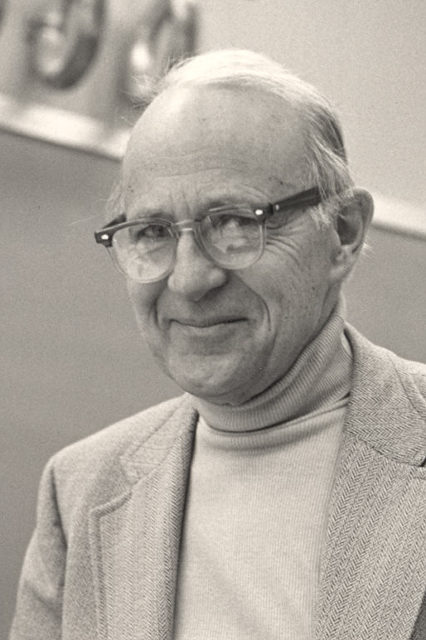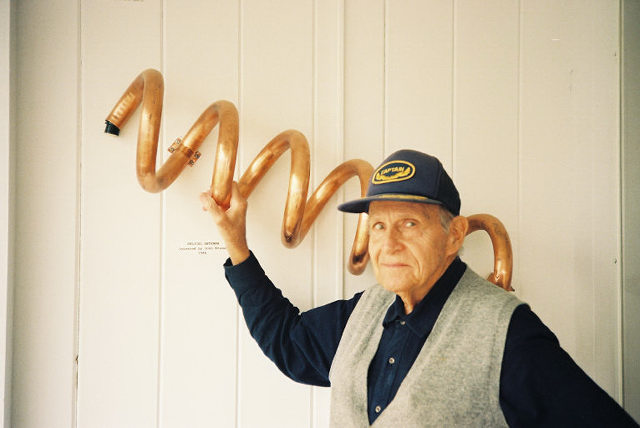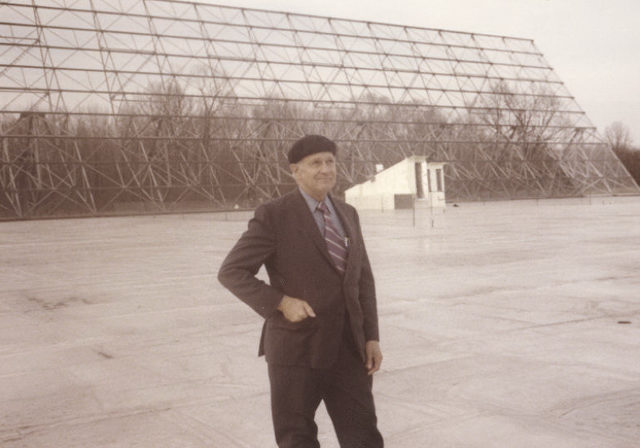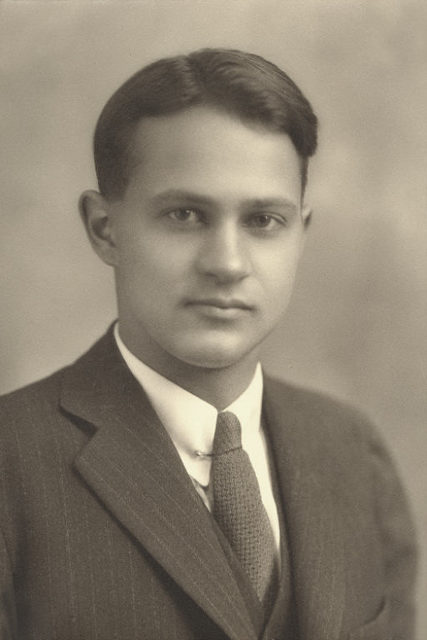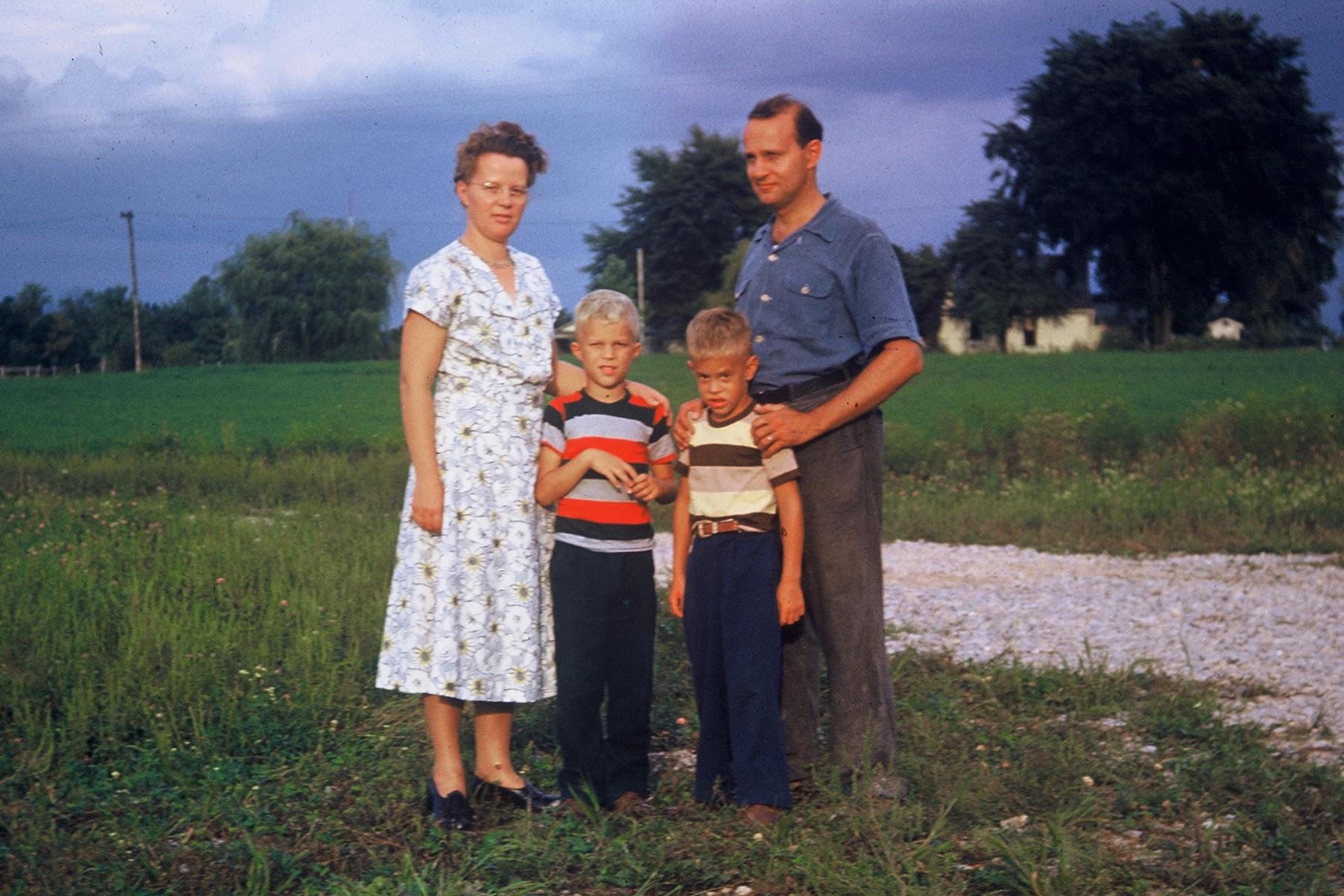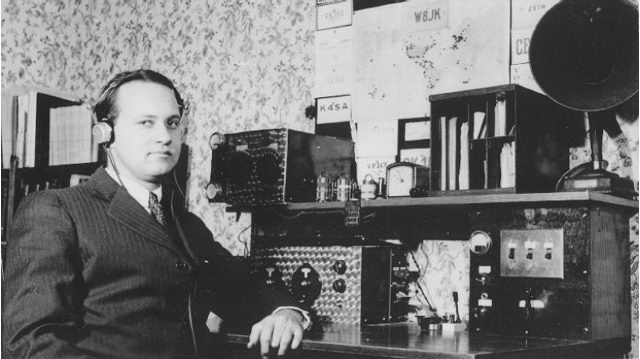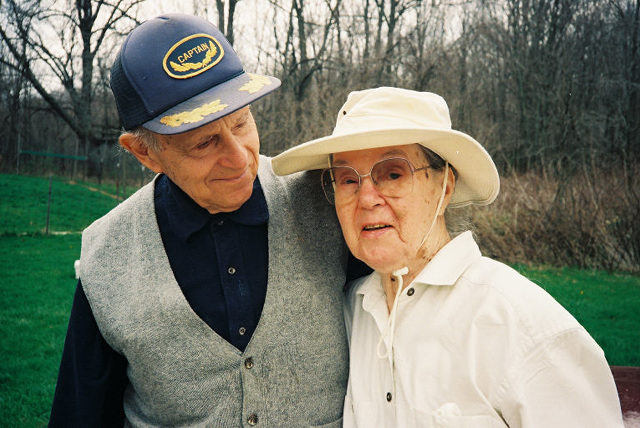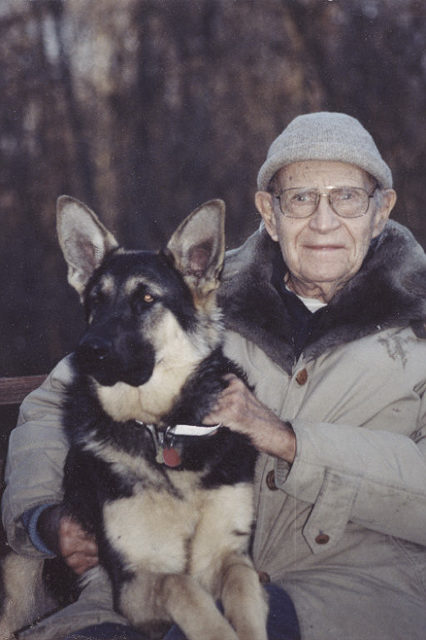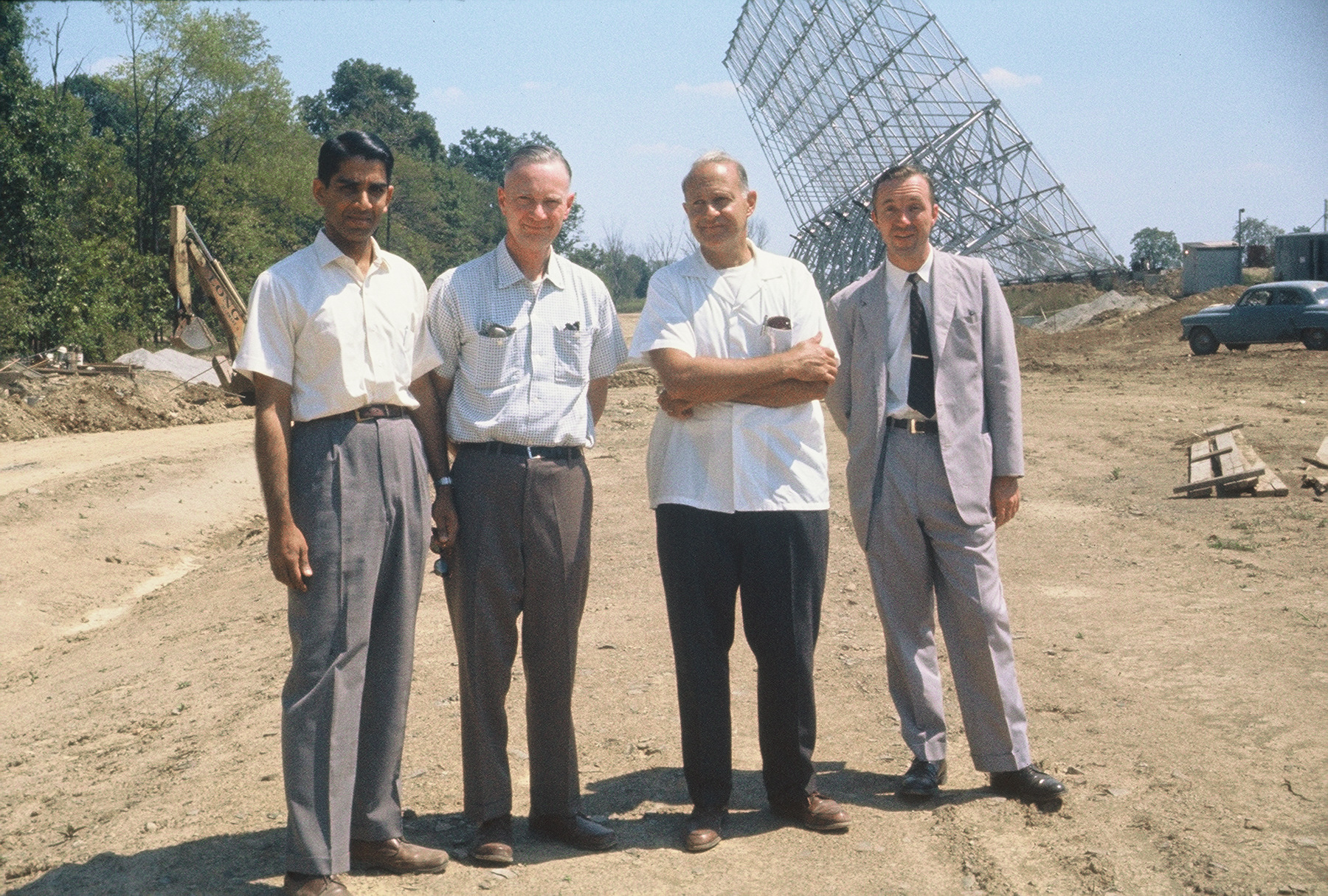| See also the Papers of Woodruff T. Sullivan III, which include a 45 minute oral interview with Kraus conducted in 1975.
Contents:
Location of collection: National Radio Astronomy Observatory, Archives, 520 Edgemont Rd., Charlottesville, VA. Phone: 1-434-296-0203, email: archivist at nrao.edu
Title and dates of the collection: Papers of John Daniel Kraus, 1895-2004
Size of the collection: 53 linear feet.
Papers/Records created by: Kraus, John Daniel (1910-2004)
Short description of collection: The papers document the career, research, and personal life of John Daniel Kraus, Taine G. McDougal Professor of Electrical Engineering and Astronomy at Ohio State University, founder and Director of the Ohio State-Ohio Wesleyan Radio Observatory. The papers include family and professional correspondence and papers, notes and papers on antenna design, drafts of books and professional publications, awards and certificates, photographs, materials on the Kraus Wilderness Preserve, and other materials covering a period from 1895 until John Kraus' death in 2004.
Top
Selected search terms:
- John Daniel Kraus, 1910-2004
- Radio astronomy - History
- Radio telescopes
- Antennas (Electronics)
- Ohio State University
- Ohio Wesleyan University
- Big Ear
- Presbyterian Church in the United States. Executive Committee of Foreign Missions.
- Kraus Wilderness Preserve
- Kraus, Edward Henry, 1875-1973
Top
Biography:
John Daniel Kraus was born June 28, 1910. He received his Bachelor of Science degree in 1930 and his doctorate in physics in 1933, both from University of Michigan. During his time at Michigan he did millimeter and meter wavelength radio experiments and also nuclear research with the University's newly completed cyclotron.
During World War II, Kraus worked at the Naval Ordnance Laboratory degaussing electromagnetic fields of steel ships to make them safe from magnetic mines, and then at Harvard's Radio Research Laboratory developing receivers and antennas for radar counter-measures. He joined the faculty at Ohio State University in 1946 and remained there for his entire academic career. He was the Taine G. McDougal Professor of Electrical Engineering and Astronomy, and founded and directed the Ohio State-Ohio Wesleyan Radio Observatory. When a grant of $2,000 allowed him to buy steel, he and his students built one of the first radio telescopes in the United States, an array of 96 helices, completed in 1953, that operated at 250 MHz. Kraus then went on to design and build the "Big Ear" radio telescope, completed in 1965. "Big Ear" was a fixed parabolic antenna, measuring 110 by 21 meters; it received reflected rays from a tiltable flat reflector panel, and the parabolic antenna in turn focused the signal to a central point at ground level. With it, Kraus and other astronomers studied some of the most distant known objects at the edge of the universe, and produced extensive surveys of the radio sky. His many other antenna designs include the bi-directional W8JK wire beam antenna widely used by radio amateurs, the corner reflector, and the helical beam antenna, used in communication and global positioning satellites.
Following the completion of the all Sky Ohio State radio source survey and the loss of funding from the NSF, Big Ear was used for many years by Kraus and his students to search for intelligent life elsewhere in the Universe. Kraus founded Cosmic Search, a magazine devoted to the search for extra-terrestrial intelligence, also including historical articles about radio astronomy, which he edited and published from 1979-1982.
A dedicated teacher, Kraus had a profound and lasting effect on his students; he maintained friendships with many of his students after they completed their degrees, and followed their careers with interest. Books Kraus authored included Antennas, Radio Astronomy, and Electromagnetics, all of which had multiple editions and were translated into many languages, as well as the autobiographical Big Ear and Big Ear Two. Kraus retired from Ohio State in 1980, but continued to work at the observatory as Professor Emeritus into the 1990s.
Kraus was a long-time radio amateur, licensed as W8JK. Through the 1930s, Kraus maintained regular contact with two missionaries in Belgian Congo, one a doctor running a medical clinic. Their transmissions served as a means for many missionaries of the Presbyterian Church in the United States and their extended families in the U.S. to transmit both routine and emergency news in a timely way, and allowed the doctor to arrange medical consultations with specialists in Ann Arbor. Kraus contributed many articles to CQ, the radio amateurs' journal; in 1996, Dayton Hamvention honored Kraus as the recipient of its Special Achievement Award, and in 2001, CQ named Kraus to the inaugural class of its Amateur Radio Hall of Fame.
Kraus served on both the National Science Foundation and Associated Universities committees involved in the earliest planning for the development of the National Radio Astronomy Observatory, and in 1955, he was part of the small group that recommended Green Bank WV as the site for NRAO.
In 1976 Kraus and his wife, Alice, donated the Kraus Wilderness Preserve, 80 acres of woodland and meadow adjacent to their home, to Ohio Wesleyan University for use by Ohio Wesleyan and Ohio State Universities, and they endowed scholarships to enhance environmental learning for students at the two universities.
Kraus was elected as a Fellow of the Institute of Electrical Engineers (IEEE) in 1954 and to the National Academy of Engineering in 1972. His many awards and recognitions included the U.S. Navy Meritorious Civilian Service Award in 1946, the Ohio State University Sullivant Medal in 1970, and the Outstanding Achievement Award of the University of Michigan in 1981. He received the 1984 Centennial Medal, the 1985 Edison Medal and the 1990 Heinrich Hertz Medal from the IEEE, as well as the Distinguished Achievement Award of the IEEE Antennas and Propagation Society in 2003.
Kraus married Alice Linnea Maria Nelson in 1941; they had two sons, John Jr. and Nelson.
Kraus died in Columbus, Ohio, on July 18, 2004.
Top
Accession history: This collection was donated to the NRAO in May 2005 by the Kraus estate. The bulk of the material was shipped to NRAO over the remainder of 2005, with periodic additions received from the estate executor through 2008.
Top
Access to collection: No restrictions. The Archives are open part-time; contact the Archivist for appointment.
Top
Restrictions on use of collection: See below for restrictions on the John E. Pfeiffer Radio Astronomy Correspondence. Otherwise, no restrictions.
Top
Publication rights: Copyright for personal and research papers has been assigned to the NRAO/AUI Archives; all requests for permission to publish or quote from manuscripts must be submitted in writing to the Archivist. Copyright for Antennas, Electronmagnetics, and Kraus publications in scientific journals remains with the original publishers. Copyright for Radio Astronomy, the Big Ear books, and Our Cosmic Universe is held by the Kraus Estate; contact the Archivist with permission requests.
Top
Preferred citation: National Radio Astronomy Observatory/Associated Universities, Inc. Archives, Papers of John Daniel Kraus, <series/unit/subunit/box #>. After the initial citation, abbreviations may be used: NRAO/AUI Archives, Kraus Papers, <series/unit/subunit/box #>.
Top
Processing notes: This collection was processed by Ellen N. Bouton and Evelyn Braintwain, beginning in 2006 with initial indexing. Final arrangement, description, indexing, foldering and boxing of this material was begun in February 2007 and completed in August 2009. During the processing, photocopies were made to replace thermofax sheets and newspaper clippings, fasteners were removed, and materials were removed from binders of various types. Duplicates were discarded.
Top
Scope and Contents of Collection
John Kraus' papers are separated into series, and then into units as needed.
General Correspondence Series: Kraus filed his general correspondence alphabetically in three separate chronological sequences, one for the 1930s through mid-1940s, one for the mid-1940s through the mid-1970s, and one for the mid-1970s until his death in 2004. These separate sequences have been combined into one alphabetical sequence. Kraus' filing scheme has been generally retained: alphabetical by correspondent and chronologically within each correspondent, with some correspondents being company or institution names, but most being personal names. Reprints, photographs, and other materials have been retained with the relevant correspondence as originally filed by Kraus. The correspondence covers a very wide range of both personal and professional interests and topics. Kraus' manilla filing folders, which were discarded, were sometimes annotated with various addresses or phone numbers of the correspondent, and occasionally with names of spouses and names and ages of children. Correspondence related to Kraus' publications, patents, lectures, and awards, as well as the correspondence he included in his subject files, has been retained with the appropriate material as Kraus originally filed it. The general correspondence covers the period 1926-2004. Size: 6.5 linear feet. Click here for an itemized listing of the General Correspondence.
Four sets of correspondence have been organized as separate units.
- Antenna Correspondence Unit: This unit includes correspondence from 1935-1940 originally filed by Kraus in a single folder labeled "Antenna Correspondence." The majority of the correspondence is on the flat top beam antenna, but other types of antennas, their construction and operation, and other issues related to antennas are also discussed. Kraus labeled one small subset of the correspondence as "Used in Big Ear" and another as "Not yet used." Remaining correspondence in the unit has been divided by year, but not sorted or indexed otherwise. See also the Amateur Radio Miscellaneous correspondence in the General Correspondence Series. Correspondence related to the efforts to save the Big Ear telescope and its subsequent demolition is filed with the Big Ear telescope materials in the Antennas Unit of the Notes and Papers Series. Size: 0.5 linear feet.
- ON4CSL Correspondence Unit: In November 1933 Kraus, operating as W8JK, made ham radio contact with ON4CSL in the Belgian Congo, a station operated by Carroll Stegall, an American missionary who had lived in the Congo for 20 years. Kraus began regular contact with Stegall, and their on-air conversations became conduits for news that bypassed the multiple months needed for paper mail. In 1936, Kraus helped Dr. George Westcott set up his own station at his clinic in the Congo, ON4CGW. Kraus maintained regular contact with both Stegall and Westcott, and soon their transmissions served as a means for many missionaries of the Presbyterian Church in the United States and their extended families in the U.S. to transmit both routine and emergency news in a timely way, and allowed Westcott to arrange medical consultations with doctors in Ann Arbor. Kraus, Stegall, and Westcott continued in contact until the fall of 1939, when the Belgian government ordered all amateur stations shut down because of the war in Europe. This unit includes correspondence between Kraus and missionary families in the U.S. and with the Executive Committee of Foreign Missions about the messages going to and from the Congo, as well as Kraus' notes about his transmissions. See also correspondence with Ray F. Cleveland, Carroll Stegall, and George Westcott in the general correspondence series. This unit includes correspondence and transcriptions of transmissions for the period November 1933 through November 1939. Size: 1 folder. Note: This material has been filed under the letter O in the General Correspondence alphabetical sequence.
- John E. Pfeiffer Radio Astronomy Correspondence Unit: This collection of letters and articles was gathered by John Pfeiffer while he was preparing his book on radio astronomy and its history, The Changing Universe (Random, 1956). Pfeiffer gave the letters to Kraus, who transmitted them to the Ohio State University Library, Division of Special Collections, in 1976. Kraus kept copies of all the material, and it is the copies that are here included, along with some additional material collected in 1959 by Reed Crone, Kraus' research assistant, and the correspondence related to the transmission of the papers to the Library. The letters include correspondence with members of the Karl G. Jansky family, with Grote Reber, George Southworth, and Walter Baade. Also included are articles on Jansky and his discoveries from Bell Laboratory Record, a transcript of a radio broadcast on May 15, 1933, and C.M. Jansky's 1956 presentation about his brother to the American Astronomical Society. Copying of correspondence is prohibited; for permissions contact the Ohio State University Library, Division of Special Collections. The correspondence covers the period 1933-1976. Size: 1 folder. Note: This material has been filed under the letter P in the General Correspondence alphabetical sequence.
- Family Correspondence Unit: This unit includes correspondence to/from Kraus' parents, Edward and Lena Kraus, Kraus' sister Margaret Kraus Ramsdell, Edward T. Ramsdell, Alice Nelson Kraus, and John D. Kraus. John Kraus' letters to family from Germany in 1934 are accompanied by a journal for the trip. A typed transcript of letters written from Europe in 1926 by Edward H. Kraus, prepared by John Kraus, Jr. in 1989, is also included; the originals of these letters are with the Edward H. Kraus archive at University of Michigan. Correspondence in this unit is from 1926-1957. See also the Kraus Family Materials Unit in the Notes and Papers Series. Size: 0.5 linear feet. Click here for an itemized listing of the Family Correspondence.
Top
Notes & Papers Series: Kraus' notes and papers have been divided into topical units.
- Amateur Radio Unit:This unit includes correspondence, notes, photos, selected QSL cards, license application forms, amateur radio operator licenses, amateur radio station licenses, and government rules and regulations related to Kraus’ involvement with amateur radio from 1926 through 1994. Also included is a degree direction finder Kraus made for his ham radio work. See also the General Correspondence Series for Amateur Radio Miscellaneous correspondence and correspondence with Ray F. Cleveland, Carroll Stegall, and George Westcott; ON4CSL Correspondence Unit; the Lectures Series; Amateur Radio Clippings Subunit; and the 8AFJ and W8JK log books in the Log and Data Books Series. A collection including Kraus' books on amateur radio, additional QSL cards, photos of pre-World War II radio sets, and some equipment were donated by the Kraus estate to the Southern Appalachian Radio Museum in Asheville NC. Size: 0.5 linear feet.
- Antennas Unit: This unit includes notes, papers, calculations, drawings, charts, and occasional correspondence on many types of antennas, with a particular focus on helical antennas, covering a period from approximately 1935 through 2004. Material related specifically to the Ohio State University Big Ear telescope is included in the subunit below. See also antenna-related materials in the Patents Series, in the Newspaper Clippings Unit in the Collected Publications Series, and with general correspondence, amateur radio correspondence, and antenna correspondence. Size: 1.0 linear feet. Click here for an itemized listing of folders in the Antennas Unit.
- Big Ear Subunit: In 1956 Ohio State University and Ohio Wesleyan University signed a joint agreement for the cooperative establishment and operation of a radio observatory on a site owned by Ohio Wesleyan. Ohio State University would be responsible for construction of the radio observatory and associated facilities on the site. Construction was begun in 1956 and completed in 1965. "Big Ear" was a fixed parabolic rectangle, measuring 110 by 21 meters; it received reflected rays from a tiltable flat reflector panel, and the parabolic antenna in turn focused the signal to a central point at ground level. With it, Kraus and other astronomers studied some of the most distant known objects at the edge of the universe, and produced extensive surveys of the radio sky. In December 1982, Ohio Wesleyan decided to end the joint agreement signed in 1956 in order to sell the land to a developer. Despite opposition from Kraus and the radio astronomy community over an extended period, the telescope was demolished in 1998 to add nine holes to an adjoining golf course. This subunit includes materials from 1950-2004 related to the Big Ear telescope: a copy of the 1956 joint agreement; correspondence, press releases and clippings related to the battle to save the telescope; material on contracts with NASA and the US Air Force for use of the antenna; and material on the antenna demolition. For Kraus' description of his immediate personal reaction to the news in 1982 that Ohio Wesleyan was selling the telescope site to developers, see chapter 27 of his book Big Ear Two and also the 5th draft for the book and chapter. For newspaper clippings on Big Ear, see the Newspaper Clippings Unit in the Collected Publications series. Size: 1.5 linear feet. Click here for an itemized listing of folders in the Big Ear Subunit.
- Interference Subunit: The Ohio State University Radio Observatory experienced interference problems from various local projects: radio and television antenna towers, electrical power lines, the United States Air Force, and land development, from 1962 through 1987. This subunit includes correspondence, newspaper clippings, journal cuts, diagrams, maps, and reports. Primary correspondents are John Kraus, Fred Albertson, Robert S. Green, Joel H. Levy, Ben F. Waple, and Senator Stephen M. Young. Folder titles used are the titles from Kraus’ manila folders. Items are in order as Kraus filed and/or paper clipped, only put in order by dates. Size: 0.5 linear feet.
- Kraus Family Materials Unit: This unit includes correspondence, notes, photos, newspaper clippings, and journal cuts from 1916 through 2003. Family materials include Edward H. Kraus’ bibliography, reprints, lectures, talks, and reports; Edward H. Kraus' 1902 article "The 80th Birthday Celebration for Prince-Regent Luitpold of Bavaria" translated and with a foreword by John D. Kraus in 1994; John D. Kraus’ parents’ obituaries; Alice Nelson Kraus’ anatomy notebooks and drawings from her University of Michigan Master of Science (Bacteriology) work; Margaret Kraus Ramsdell’s research notes; and information and correspondence about the Edward Kraus Lectureship and the Margaret Kraus Ramsdell Fellowship. John D. Kraus materials include a folder of his writings and drawings from 1916-1926; Log to Biological Station and Engineering Camp (8/3/1922-8/7/1922); trip to Germany (1934); miscellaneous notes (circa 1935-1938); Pacific coast trip notes (October 1937); farming and gardening (1949-1959). Primary correspondents are Edward Kraus, Lena Kraus, and John D. Kraus. Items are in order as Kraus filed and/or paper clipped them. For other family materials, see also Kraus Family Correspondence Unit in the Correspondence Series, the Photographs and Moving Images Series, and the Diplomas and Awards Series. Size: 1.0 linear feet.
- Kraus Wilderness Preserve Unit: In 1976 John and Alice Kraus donated 80 acres of land to Ohio Wesleyan University as a wildlife refuge and for environmental research by students at Ohio Wesleyan and Ohio State Universities. This unit includes the Kraus booklet "The Kraus Wilderness Preserve: The Canary in the Mine" (October 1996), Ohio State University and Ohio Wesleyan University student research papers, notes on the Krauses' own explorations of the Preserve, photos, newspaper clippings, and correspondence. Material covers the period 1972-2004. Size: 1.0 linear feet.
- Ohio State University/Ohio Wesleyan University Unit: This unit contains materials on Kraus' relationships with Ohio State University and Ohio Wesleyan University over the period 1945-2004. Included are 1945-1946 correspondence about his application and appointment as Associate Professor in Electrical Engineering in 1946, miscellaneous OSU correspondence and papers for 1962-1972, OSU contracts and emeritus appointment letters for 1971-2003, records of Kraus' gifts to OSU in 1987-1989 and 1991, and records of his gifts to Ohio Wesleyan University in 2002-2004. See also the Kraus Wilderness Preserve Unit for materials on the 1976 donation of land to Ohio Wesleyan University. Size: 0.25 linear feet.
- Ornithology/Biology Unit: This unit includes correspondence on birds (1983-2003), notes, photos, charts, bird journals, collected reprints, newspaper clippings, journal cuts, and two unpublished, undated stories, "Hoot" and "An Incredible Flying Machine." Topics include bird migration, owls, daily life of the swallow, nature conservation, and the effect of electromagnetic fields on the environment. Also included is a folder containing an unpublished manuscript, "Effects of 60 Hz Magnetic fields on Daphnia Magna, Chironomid Diptera and Other Organisms," by Hazel L. Mouzon and John D. Kraus, June 8, 1994, with related correspondence, notes, and journal cuts. Photos are of owls, swallows that returned to nest in Kraus' garage year after year, nests, and eggs. Dates of materials: 1977-2003. Published articles "Early Bird" (Delaware County Bird Club Newsletter, March, 3, 1991) and "Short Note: My Summer Guests" (The Ohio Cardinal, 27 (2), 80, Winter 2003/2004), with related corrrespondence, are filed in the Journal Articles Unit. Size: 0.5 linear feet.
- Radio Astronomy Research Unit: This unit includes correspondence, notes, maps, diagrams, charts, graphs, reprints, newspaper clippings, reports, and photos related to various radio astronomy research projects from 1956 through 1995. Most, but not all, research projects utilized Ohio State instruments. Primary correspondents are Mike Davis, Robert S. Dixon, and Beverly Harris Wills. Kraus’ original folder titles have been retained. Also included is a folder of Kraus' gravity wave work with Ulrich Gerlach and Eric Braeden, 13 June 1990 through 23 November 1990. Additional materials relating to Kraus’ research for published papers are found in the Kraus Publications Series. Material on the history and development of U.S. radio astronomy is found in the Kraus Notes and Papers Series, United States Radio Astronomy Unit. Size: 1.0 linear feet. Click here for a folder listing for the Radio Astronomy Research Unit.
- Satellites Unit: This unit includes notes, diagrams, correspondence, charts, graphs, reports, newspaper clippings, photos, maps, and journal cuts related to Kraus’ study of Explorer, Sputnik III, Vanguard, Voyager, LEO and other satellites from 27 May 1955 through January 2000. Kraus' original folder titles have been retained. Size: 2.0 linear feet. Click here for a folder listing for the Satellites Unit.
- United States Radio Astronomy Unit: This unit includes materials on the history and development of radio astronomy in the United States, and has been divided into three subunits.
- National Science Foundation and Office of Naval Research Subunit: This subunit includes both National Science Foundation Advisory Panel on Radio Astronomy correspondence and Office of Naval Research correspondence from 1954 through 17 February 1956 related to Kraus’ application for NSF funding of the Ohio State radio antenna, and Kraus’ work with the Advisory Panel during discussions on formation of a national facility for radio astronomy (ultimately National Radio Astronomy Observatory). Primary correspondents are Bart. J. Bok, Jesse L. Greenstein, John P. Hagen, Helen S. Hogg, Geoffrey Keller, John D. Kraus, R. Minkowski, R. J. Seeger, Merle A. Tuve, and Alan T. Waterman. Size: 1 folder. Click here for an itemized listing of folders in the NSF and ONR Subunit.
- Largest Feasible Steerable Paraboloid Subunit: The subunit includes correspondence, reports, reprints, notes, diagrams, and meeting minutes, from 12 October 1964 through 28 April 1965, about theory and design work at National Radio Astronomy Observatory for a Largest Feasible Steerable Paraboloid (LFSP), later called Largest Feasible Steerable Telescope (LFST). Correspondents include Ronald N. Bracewell, John W. Findlay, David S. Heeschen, John D. Kraus, and Gart Westerhout. Size: 1 folder.
- Smithsonian Large Telescope Unit: On January 28, 1969, a bill was introduced to Congress authorizing the Smithsonian Institution to acquire lands and to design a radio-radar astronomical telescope. A committee was formed that met to discuss, research, plan, and recommend on "the proposal that the Smithsonian Institution should take the lead in working to bring into being a large new radio-radar antenna," but on May 21, 1971, Smithsonian decided to suspend further activity and planning. This subunit includes correspondence, meeting agendas, meeting minutes, newspaper clippings, notes, and diagrams related to discussion from 10 January 1967 through 8 June 1971 about the project. Primary correspondents are John W. Findlay, John D. Kraus, S. Dillon Ripley, and Fred L. Whipple. Size: 1 folder.
- World War II Materials Unit: During World War II, Kraus worked at the Naval Ordnance Laboratory degaussing electromagnetic fields of steel ships to make them safe from magnetic mines, and then at Harvard's Radio Research Laboratory developing receivers and antennas for radar counter-measures. This unit includes a photo and menu from the USS Walke; official US Navy papers; notes, charts, graphs, diagrams and reports from antennas and transmission lines; and correspondence regarding the publication Very High Frequency Techniques, (McGraw-Hill), 1947. Materials cover the period from 1940 through 1947. Size: 0.25 linear feet.
Top
Kraus Publications Series: This series includes Kraus' publications in books, journals, and conference proceedings, his books, his observatory reports, and Cosmic Search, the journal he published and edited. It includes drafts, final versions, proofs, journal cuts, reprints, and correspondence related to the various publications. The series has been divided into four units.
For a full bibliographic listing of Kraus publications, click here.
- Articles Unit: This unit includes Kraus' articles published in a wide variety of journals, magazines, books, and conference proceedings. Original manuscripts and drafts have been retained. Correspondence, either between Kraus and the editors or between Kraus and his co-authors, related to the drafts, editing, and publishing process has been filed with the relevant publication. If neither journal cuts nor reprints are available, we have retained a photocopy of the article. An additional folder includes copies of book reviews written by Kraus for a variety of journals. Material covers the period 1933-2004. Size: 2.5 linear feet. Click here for an itemized listing.
- Books Unit: This unit and its subunits include drafts of some of Kraus' books, correspondence related to the drafts, editing, publishing, and translation processes, and correspondence from users. Kraus' first book, Elements of Electromagnetics, was published by Long's College Book Company. McGraw-Hill published the three editions of Antennas, the five editions of Electromagnetics, and the first edition of Radio Astronomy, and also handled the various translations of those titles. When McGraw-Hill decided not to reprint Radio Astronomy, Kraus formed his own publishing company, Cygnus-Quasar, and published a reprinted 1st edition of Radio Astronomy, a 2nd edition of Radio Astronomy, Big Ear, Big Ear Two, and Our Cosmic Universe. The unit includes general publisher correspondence from 1946-1972, both with McGraw-Hill and with other publishers interested in Kraus' work, McGraw-Hill royalty and sales information from 1953-1974, and miscellaneous Cygnus-Quasar Books materials for the period 1991-2003. Size: 0.25 linear feet. Material related to specific titles is divided into subunits.
- Antennas Subunit: This subunit includes three editions of Antennas: 1st edition in 1950, 2nd edition in 1988, and 3rd edition, titled Antennas for All Applications, with co-author Ronald J. Marhefka, in 2002, as well as translations of the book in Japanese and Portuguese (1st ed.), Greek (2nd ed.), Chinese (3rd ed.), and English versions published in India (2nd and 3rd eds.). Editorial correspondence,including records of book sales and correspondence with contributors to the 3rd edition, covers the period 1949-2002; correspondence and reviews from users covers the period 1963-2004. Notes and correspondence on corrections made in subsequent editions were discarded, but the book copies Kraus annotated with corrections have been retained. Size: 3.0 linear feet.
- Big Ear Subunit: Kraus' autobiographical book, Big Ear was published by Cygnus-Quasar Books in 1976, and describes his early life, his years at University of Michigan, his involvement with ham radio and experimentation with various types of antennas, his service during World War II, his career at Ohio State, and the construction of and research with "Big Ear," the Ohio State University radio telescope. This subunit includes notes related to the book, original photographs, reviews, extensive correspondence with readers, material on the publication of the Japanese translation in 1981, 1st-3nrd drafts, and a 5th draft manuscript which, according to Kraus' note, has many important details not included in the final book. A soft-bound copy, a cloth bound copy, and a copy of the Japanese translation are also included. Material covers the period 1976-1993. Size: 1.0 linear feet.
- Big Ear Two Subunit: Big Ear Two, a revised and greatly expanded version of Big Ear, was published by Cygnus-Quasar in 1995. This subunit includes 1994-1996 correspondence related to permission requests and the printing process, a set of photos with captions that were included in the book, extensive correspondence from readers, and a copy of the book. Size: 0.5 linear feet.
- Electromagnetics Subunit: This subunit includes the five editions of Electromagnetics: 1st edition in 1953, 2nd edition, with co-author Keith R. Carver, in 1973, 3rd edition in 1984, 4th edition in 1992, and 5th edition, titled Electromagnetics with Applications, with co-author Daniel A. Fleisch, in 1999, as well as translations of the book into Spanish (1st and 5th eds.), Greek (4th edition), Korean (4th edition), and the Taiwanese and the International English versions (2nd edition). Editorial correspondence, including records of book sales, covers the period 1951-2001; correspondence from users covers the period 1982-1997. Notes and correspondence on corrections made in subsequent editions were discarded, but the book copies Kraus annotated with corrections have been retained. Size: 2.5 linear feet.
- Elements of Electromagnetics Subunit: This text by John D. Kraus, published in 1949 by Long's College Book Company and printed by Edwards Brothers, Inc., was written especially for the undergraduate introductory course in field theory course at Ohio State University. This subunit includes 1948-1949 editorial correspondence about the production process, and Kraus' personal copy of the book with annotations and corrections. Size: 0.25 linear feet.
- Our Cosmic Universe Subunit: This subunit includes materials from 1976 to 1999 on Our Cosmic Universe, published by Cygnus-Quasar Books in 1980. Originally the book was to have been called Eyes and Ears on the Universe, and was to have been published by Scientific American in their Illustrated Library series. Kraus's manuscript was reviewed and edited, a contract was signed with Scientific American, he received prepublication royalty checks, and a sample book, with blank pages but the proposed illustrated cover and cloth spine (now included in this subunit), were sent to Kraus. For unknown reasons, Scientific American then dropped the project, and Kraus went on to modify the manuscript and publish it in 1980 under his Cygnus-Quasar imprint as Our Cosmic Universe. Based on some of the early correspondence and photo permission requests, Kraus may also have considered calling the book ABCs of Space or ABCs of SETI, envisioning it as an expansion of the ABCs column in his magazine Cosmic Search. This subunit includes 1976-1978 editorial correspondence with Scientific American, a November 1977 version of the Eyes and Ears of the Universe manuscript, correspondence and notes from 1976 to 1999 related to the writing of the Eyes and Ears on the Universe manuscript and the writing and publication of Our Cosmic Universe, and soft-cover and cloth-bound copies of the book. Size: 1.0 linear feet.
- Radio Astronomy Subunit: This subunit includes two editions and several reprintings of Radio Astronomy: the 1st edition published by McGraw-Hill in 1966, the 1982 Cygnus-Quasar Books reprint of the 1st edition, the 2nd edition published by Cygnus-Quasar in 1986, a November 2004 printing of the 2nd edition, a November 2005 printing of the 2nd edition that includes a Solutions Manual with photos of Kraus, and the 1973 Russian translation of the 1st edition. The 2004 and 2005 printings were produced after Kraus' death by his estate, and printed by University of New Hampshire Printing Services. The 1st edition includes a chapter on Radio-Telescope Receivers written by Martii E. Tiuri; that chapter in the 2nd edition was written by Tiuri and Antii V. Räisäanen. Also included are copies of the 1st and 2nd editions with Kraus' notes and corrections. The unit includes review clippings for the 1st edition, and 1981-1982 correspondence about the reprinting of the 1st edition. Material related to the 2nd edition includes a 1981 outline, correspondence for 1981-1995, printing and sales records for 1985-2001, correction pages dated 2/26/1986 for the 2nd printing and 3/14/1988 for the 3rd printing, and the masters for the Solutions Manual. A large composite photo of Grote Reber's Dennistoun antenna array, used as an illustration in chapter 6 of the 2nd edition, is filed with other Kraus oversized materials. At the time of his death, Kraus was working with Christopher K. Walker on a planned 3rd edition. Materials related to the 3rd edition cover the period 2001-2004 and include correspondence and revisions for chapters 11 and 20. Detailed sales and royalty records for the 1st edition are included with the McGraw-Hill material in the Books Unit. Size: 2.0 linear feet.
- Observatory Publications and Reports Unit: This unit includes Kraus' publications in the reports series of Ohio State-Ohio Wesleyan Radio Observatory from 1954-1962. Correspondence between Kraus and his co-authors related to the drafts, editing, and publishing process has been filed with the relevant publication. Some reports were later published in the open literature. Also included are folders containing OSU Radio Astronomy Abstracts (May 1965-January 1967) and Current Literature Listings of the OSU Radio Observatory (1966-1967). Size: 0.5 linear feet. Click here for a listing of the reports by Kraus included in this unit.
- Cosmic Search Unit: This unit includes materials dated 1974-1984 related to the magazine Cosmic Search, founded, published, and edited by John Kraus. The unit includes a full set of the magazine: vol. 1, no. 1, January 1979, through vol. 4, no. 1, serial number 13, 1982. The purpose of Cosmic Search was to present all aspects of the search for intelligent life in space, often refered to as the search for extraterrestrial intelligence, or SETI, in a popular but responsible manner. Kraus hoped with the magazine to generate funds to help finance scientific research at a time of dwindling state and federal support, and a non-profit organization, Cosmic Quest, Inc., was formed to act as publishing entity. However, the magazine ran at a loss, and ceased publication after three years, following a brief but unsuccessful attempt to find another editor. The magazine AstroSearch, published by Delta Vee, Inc., a nonprofit space corporation encouraging citizen involvement in space activities, was intended to be a merger of Cosmic Search and Delta Vee's CQ-ET Newsletter, but published only 5 issues, all in 1983; issues are included in this unit. Cosmic Search article authors included Jocelyn Bell Burnell, Ronald N. Bracewell, Arthur C. Clarke, Norman Cousins, Frank D. Drake, C.M. Jansky, Jr., Nikolai Kardashev, John Kraus, Philip Morrison, Carl Sagan, Walter Sullivan, and Virginia Trimble. A regular feature of the magazine was a column written by Kraus called, "ABCs of Space," which gave short explanations of basic concepts ranging from the Doppler effect to star spectra. Kraus also wrote a set of articles on "The First 50 Years of Radio Astronomy," intended for publication in Cosmic Search as a 5-part series. Only parts 1-2 were actually published, but the draft of part 3 and notes for part 4 are included here. The unit includes correspondence and other materials related to content, editorial, and administrative matters, as well as manuscripts, original figures, and original photographs. Folders labeled by Kraus with specific issue numbers often contain miscellaneous correspondence and other materials which are perhaps related to but not included in the issue, along with correspondence received during the period in which an issue was being prepared. Correspondence about the 1982-1983 attempt to find another editor, and about the merger of Cosmic Search and AstroSearch is also included. Size: 1.5 linear feet. Related materials: For materials on the search for extraterrestrial intelligence (SETI), see also the Records of the National Radio Astronomy Observatory, the Papers of Ronald N. Bracewell, and the Conferences and Lectures listing in the Papers of Woodruff T. Sullivan III..
- Unpublished Manuscripts Unit: This unit includes manuscripts of John Kraus' unpublished writings ranging in length from a few pages to book manuscripts. Topics are varied, including antennas, overpopulation, radio astronomy, satellites, science fiction, SETI, the "WOW" signal, and other subjects. Included with the manuscripts are correspondence, notes, diagrams, newspaper clippings, and photographs. Material is dated 1933-2003, and there are 12 undated manuscripts. Size: 2.0 linear feet. Click here for a listing for the unpublished manuscripts.
Top
Collected Publications Series: This series includes publications received by Kraus from individuals, institutions, and corporations, as well as items collected by him. Material includes journal cuts, newspaper and magazine clippings, photostats, reprints, preprints, and reports. Although some materials were requested by Kraus, there are many for which it is unclear whether they were received unsolicited or were received in response to his requests. Others, such as the newspaper clippings and journal cuts, were clearly collected by Kraus. Kraus generally collected and grouped these materials topically, and that arrangement has been retained, although if no topical groupings were discernable, items have been arranged chronologically. Reprints Kraus had filed in his general correspondence files for particular persons have been retained with the correspondence in the General Correspondence Series. Preservation photocopies have been made of newspaper clippings. Reprints of Kraus' own publications are included in the Publications Series.
- Reprints and Reports Unit: This unit includes reprints and reports collected by Kraus from 1932 through 1988. Kraus’ filing categories have been retained. Most of the reprints are arranged alphabetically by author and include Ernest J. Abbot, Arthur Adel, the American Institute of Electrical Engineers, Andrew Alford, S. Ya. Braude, T.L. Cline, Frank C. Dehler, Dieckmann & Munich, Paul F. Goldsmith, C.V.Heer, Nick Kardashev, Edward T. Ramsdell, Donald R. Rhodes, Bradley E. Schaefer, Harlow Shapley, R. Wallace Teed, and F. L. Walls. Topical categories of collected reprints and reports include Cyclotron, Latest Astronomical References (1979-1980), the History of Radio Astronomy 1898-1983 by Sarah Stevens-Rayburn, and a Miscellaneous file of reprints and journal cuts. Kraus’ notes, charts and graphs are dispersed throughout the files. Size: 1.0 linear foot.
- Newspaper Clippings Unit:
- Clippings about Kraus Subunit: This subunit includes clippings of newspaper and magazine articles about John Kraus or that make mention of him, dated 1955 through 1981. The sources include Ohio State University Monthly, Columbus Citizen, Ohio State Journal, Columbus Dispatch, Ohio State Lantern, Detroit Free Press, Delaware Gazette, Science, AA News, New Scientist, and New York Times. The material covers Kraus’ work in radio astronomy. Size: 1 folder. Click here for a listing of the clippings.
- Amateur Radio Clippings Subunit: This subunit includes clippings of newspaper and magazine articles dated 1934 through 1940 related to Kraus’ involvement with ham radio and W8JK. Also included are clippings about his radio contact with Carroll Stegall, a missionary in Belgian Congo. Size: 2 folders.
- Environmental Issues Clippings Subunit: This subunit includes clippings of newspaper and magazine articles dated 1976 through 1982 reflecting Kraus' interest in the environment and ecology. Size: 1 folder.
- Helix and Big Ear Telescope Clippings Subunit: This subunit includes newspaper and magazine clippings of articles dated 1952 through 1995 that refer to Kraus’ construction and use of the Helix and Big Ear Telescopes. Sources include Ohio State University Monthly, Columbus Citizen, Ohio State Journal, Columbus Dispatch, Ohio State Lantern, Detroit Free Press, Delaware Gazette, Science, AA News, New Scientist, New York Times, Newsweek, Washington Post, Life, Science News, and Discovery. Size: 0.5 linear feet.
- Jupiter and Venus Clippings Subunit: This subunit includes clippings of newspaper and magazine articles dated 1956 related to radio waves received from Jupiter and Venus by the Ohio State University Radio Observatory. Size: 1 folder.
- Scientists Clippings Subunit: This subunit includes clippings of newspaper and magazine articles dated 1947 through 1949 about other scientists. All items are filed according to Kraus’ original arrangement. Size: 1 folder.
- Miscellaneous Clippings Subunit: This subunit includes clippings of miscellaneous newspaper and magazine articles dated 1935 through 1990. Sources include The New York Times, AA News, Christian Science Monitor, Ohio State Lantern, Columbus Dispatch, Science, Time, Nature, Sky & Telescope, Mercury, and Physics Today. Kraus’s notes and some correspondence are included. Size: 2 folders.
Top
Patents Series: Kraus filed for and received patents on a number of antenna designs and enhancements. This series includes patent applications and patents, as well as related correspondence for the period 1939-1995. 0.5 linear feet.
Top
Lectures Series: This series includes original copies, drafts, transcripts, notes, announcements, newspaper clippings, correspondence, brochures, photos, and transparencies of talks and lectures given by Kraus from 22 February 1933 through 26 April 1991. Organizations include University of Michigan, Ohio State University, Ohio Wesleyan University, Institute of Radio Engineers, American Church in Berlin, Rotary Club, IRE Convention, Buffalo Hamfest, WBNS-TV, American Rocket Society, American Physical Society, NEREM, First Congregational Church Men’s Club, and Institute for Spectroscopic Studies. The lecture subjects include antennas, amateur radio, radio astronomy, research, Sputnik, radio telescopes, and space exploration. Talks presented at conferences with published proceedings are included in the Articles Unit of the Kraus Publications series. Size: 1.0 linear foot. Click here for a folder listing for the Lectures Series.
Top
Log and Data Books Series: This series includes Kraus’s log and data books from 1920 through 1970. The material covers his research on classification of animals; modern aircraft; kites; antennas; antenna designs; radio astronomy and galactic structure; gravity waves; gravitation; gravity lenses; near field-far field relations; electromagnetics; and radio telescopes. Also included are lecture notes; course notes; field test data; problems for research projects; log N-log S data; a notebook of experiments; W8JK notes and data; personal appointment books (1959-1969); and 8AFJ and W8JK log books. A photocopy of the W8JK station register for 1939-1941, with 1939 signatures of Werner Heisenberg and Laura Fermi is included with the W8JK materials; the original register is at the Bentley Historical Library, University of Michigan. Size: 3.0 linear feet plus one 4.5"x3"x12" box.
Top
Course Materials Series: This series is divided into two units, one for courses taken by Kraus and one for courses taught by Kraus.
- Courses Taken by Kraus Unit: This unit includes course outlines, course notes, notes from experiments, exams, and term papers from courses taken by Kraus at Ann Arbor High School and the University of Michigan from 1925 through 1934. Topics include astronomy, resonance, velocity of sound, spherical mirrors, the electric dynamo, light, radio engineering, physics, and the propagation of radio waves. Folder titles used are the titles from Kraus’ manila folders. Items are in order as Kraus filed and/or paper clipped. Size: 0.5 linear feet.
- Courses Taught by Kraus Unit: This unit includes course outlines, course notes, exams, student manuscripts, and correspondence from 1946 through 1994 related to astronomy, radio astronomy, and electrical engineering courses taught by Kraus at Ohio State University. Also included is a 1947-1975 listing of graduate students who obtained master's or doctoral degrees with Kraus as advisor. Most folder titles used are the titles from Kraus’ manila folders. Items are in order as Kraus filed and/or paper clipped. Size: 1.0 linear feet.
Top
Photographs, Moving Images, and Audio Series: This series includes family and professional photographs and DVDs of family home movies, negatives, slides, 8 mm films, 16 mm films, filmstrips, VHS, and audio cassette tapes. Photographers include James S. Arthur, John D. Kraus, Jr., Fumio Minozuma, the Stegall family, Bob Townsend, the Westcott family, and others. This series has been divided into three units. Inclusive size: 0.5 linear feet, plus 2 boxes 8.5x12x5.5 inches.
- Photographs Unit: This unit includes Kraus family and professional photographs,negatives, filmstrips, and slides covering a period from 1895 until July 2004, shortly before Kraus' death. Some photographs in this unit are available as digital images only, and are stored in the Archives on DVD, with links to the image from the item records; originals have been retained by the Kraus family. Photographic prints originally included in Kraus' general correspondence files, e.g. photographs of their families sent to Kraus by his correspondents, have been retained and filed with the correspondence. Photographs used in Kraus' publications have been retained where Kraus filed them with publication materials. All items in this unit have been arranged chronologically. A representative selection of photographs has been digitized; click here for the digitized photographs. Other groups of photographs and negatives include Kraus and Nelson families, Carroll R. Stegall and George Westcott photographs taken in the Belgian Congo and the US, helical antenna, Kraus family vacations, Big Ear, Michigan radio telescope, Harvard radio telescope, construction of the NRAO 140 ft telescope, USA-USSR Radio Astronomy Symposium (Green Bank, WV, 1961), Jodrell Bank, and a group of miscellaneous mostly undated photographs, negatives and filmstrips.
- Moving Images Unit: This unit includes DVDs, VHS, 8 mm and 16 mm films from 1957-2004 of Big Ear construction, Kraus lectures and demonstrations, the Kraus family, The Kraus Wilderness Preserve, and the John D. Kraus Memorial Service. The 8 mm films and 16 mm films have been transferred to DVD. Also included are a DVD of a 1987 talk by Kraus called Grote Reber: Founder of Radio Astronomy.
- Audio Unit: This unit includes an audio cassette tape "Sputnik and Other Satellite Sounds Plus Jupiter OSURO 1957"
Top
Diplomas and Awards Series: This series includes Kraus' diplomas, certificates, and awards from 1926 through 2003, with related correspondence and other materials. Five diplomas and certificates for Alice Nelson [Kraus] are also included. Size: 0.5 linear feet plus 2 boxes, 18.5"x14.75"x3". Click here for an item listing for the Awards and Diplomas Series.
Top
Miscellany Series: This series includes miscellaneous materials that do not fit well in the other series in this collection. Materials are dated 1923-2004, and cover a wide range of topics. Folders are arranged alphabetically, and in most cases Kraus' folder titles have been retained. Also included is a box of artifacts. Size: 1.0 linear feet plus one 8.5"x5.5"x12" box containing artifacts. Click here for an itemized listing of folders.
Top
|
